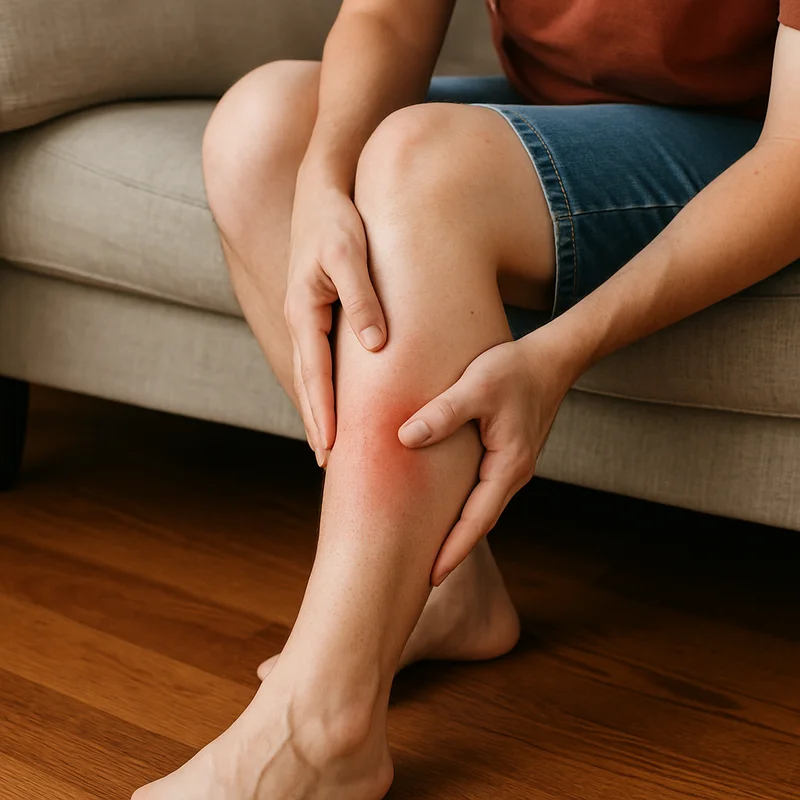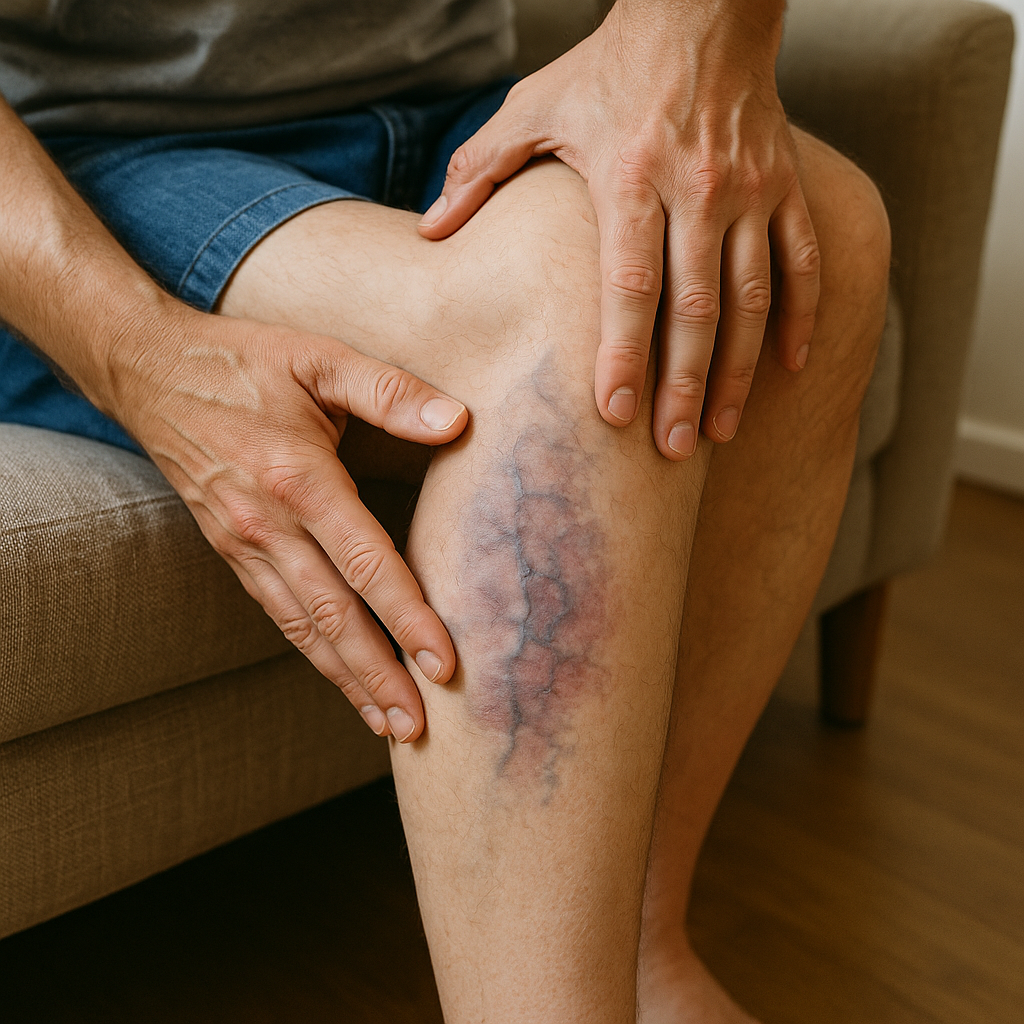Shop Now in Our Store
How to Check for a Blood Clot in Your Leg: Signs, Tests & Tips

So, here’s the thing no one really talks about until it’s a problem: you’re sitting around, maybe after a long flight or an all-nighter working at your desk, and suddenly—your leg feels weird. Maybe a little swollen. Maybe there’s this odd pain in your calf that doesn’t go away. And, because you’re either very cautious or a little too familiar with late-night health Googling, you start wondering… could it be a blood clot in the leg?
Now, before panic sets in, let’s get something straight: yes, blood clots in the leg are serious. We're mainly talking about deep vein thrombosis (DVT), a type of clot that forms in the deep veins, usually in your legs. And yes, they can travel to your lungs and cause life-threatening issues. But also—no, not every ache or tingle means you’ve got a clot. Still, it’s smart to know the signs of blood clot, how to check for blood clot symptoms at home, and when to say, “Okay, time to see a doctor.”
Let’s walk through it, step by step.
What Is a Blood Clot?
Alright, basic anatomy moment. A blood clot is like your body’s version of duct tape—it forms to stop bleeding when you're injured. But when it forms inside your vein without any obvious injury? That’s when it turns into a problem.
Types of clots
There are generally two categories here:
-
Superficial clots, which form in veins just under the skin. These are uncomfortable, but not usually dangerous.
-
Deep vein thrombosis (DVT), which happens in deeper veins, often in the thigh or lower leg. This one’s the real concern.
Why clots form in the legs
The legs are prime territory for clots because of how gravity works and how blood tends to pool there—especially when we’re sitting still for hours. Add in dehydration, poor circulation in legs, or vein injury, and boom: you’ve got the perfect setup for vein blockage.
Some common triggers? Long flights, bed rest after surgery, certain medications, and even sitting cross-legged too often (yeah, we were shocked too).

Symptoms of a Blood Clot in the Leg
So, how do you know if you’re dealing with an actual blood clot in leg or just sore muscles from leg day? Let’s break it down.
Swelling, redness, pain
The big three:
-
Swelling (especially if it’s only in one leg)
-
Redness or discoloration
-
Pain in calf or thigh—sometimes sharp, sometimes just dull and persistent
Now, here’s the kicker: the pain might feel like a cramp or soreness. Not super dramatic. That’s what makes it tricky—and why people brush it off.
DVT explained
DVT can quietly develop without screaming for your attention. You might feel warmth in the leg, see some swelling, and think, “Eh, I’ll stretch it out.” But if that clot dislodges? It could travel to your lungs and become a pulmonary embolism. That’s medical emergency territory.
This is where tuning into your body really matters. Pay attention to what feels “off,” especially if there’s leg swelling with no clear cause.

How to Check for Clots at Home
Alright, real talk: this is the part everyone wants to know. How to check for a blood clot in your leg without running straight to the ER every time your leg feels funny.
Now, disclaimer time (and I mean this 100%): at-home checks are not a replacement for medical diagnosis. That said, you can be your own early warning system if you know what to look for.
Self-examination tips
Here’s what you can do at home, especially if you’re at higher risk or just feeling unsure:
-
Compare both legs. Is one visibly more swollen or discolored than the other? Is there tenderness in one calf but not the other?
-
Feel for heat. Gently press around the swollen area. Is it noticeably warmer than the rest of your leg?
-
Flex your foot. This is sometimes called Homan’s sign (though, heads-up, it’s not super reliable). If flexing your foot back toward your shin causes pain in the calf, that’s a possible red flag. Not a sure thing—just a clue.
-
Check your skin. Is the surface shiny or tight, like it’s stretched over swelling? Clots sometimes cause subtle skin changes before anything else.
Still, there’s a fine line between being proactive and freaking yourself out unnecessarily. That’s why the next point matters a lot.
When to call a doctor
If you're checking all the boxes—pain in calf, swelling, redness, and especially if symptoms appeared suddenly—please, please don’t wait. It’s not being dramatic. It’s being smart.
Other signs that should send you straight to urgent care or the ER:
-
Shortness of breath (possible pulmonary embolism)
-
Chest pain or a rapid heartbeat
-
Fainting or coughing up blood (yes, it’s rare—but it happens)
Better to get checked and be wrong than to ignore something serious. Even doctors say this.

Ayurvedic Insights on Circulation
Okay, now let’s shift gears a little. Because while modern medicine gets most of the spotlight when it comes to vein blockage or blood clot symptoms, I’ve met more than a few folks who swear by Ayurvedic approaches. Not as a cure-all, but as a way to support healthy blood flow and reduce risk naturally.
Vata and blood flow
In Ayurveda, Vata dosha governs movement—circulation included. When Vata’s out of balance (think too much dryness, cold, irregular routines), blood flow can stagnate. That stagnation? It’s seen as one of the root causes behind clots or sluggish circulation.
Things that disturb Vata? Long sitting, stress, cold environments, and—yeah—flying. Sound familiar?
Improving leg circulation naturally
Here are a few Ayurvedic practices people often turn to:
-
Abhyanga (self-massage): Using warm sesame oil to massage your legs daily. Not just relaxing—it’s said to improve circulation and keep the channels (srotas) clear.
-
Dry brushing: Using a soft brush to stimulate the skin and lymphatic system. I was skeptical at first, but it feels great and people love it.
-
Herbal support: Triphala for detox, guggulu for circulation, and turmeric for inflammation. Always check with a practitioner though—especially if you're on meds.
-
Movement rituals: Short walks after meals, yoga postures like legs-up-the-wall (Viparita Karani), or even simple ankle rotations throughout the day.
None of this replaces a doctor, of course. But it can be part of a bigger picture—especially if you’re into holistic healing.
Diagnosis and Modern Tests
So, say you’ve noticed some symptoms—you’re worried, maybe your leg’s swollen, or the pain won’t quit—and you’ve decided it’s time to get checked. Good call.
Now, let’s talk about what actually happens at the clinic or hospital when you go in suspecting a blood clot in leg.
Ultrasound and D-dimer test
First stop? Doppler ultrasound. It’s painless, non-invasive, and honestly kind of fascinating. A tech runs a little wand over your leg, and the machine uses sound waves to check how blood is flowing in your veins. If there’s a vein blockage—a clot—that flow gets disrupted, and they’ll see it.
The other common test is a D-dimer blood test. D-dimer is a protein fragment that shows up when a blood clot dissolves in your body. High levels can mean there’s a clot somewhere (but also pop up from surgery, injury, or even pregnancy—so it’s not a standalone test).
Together, these help doctors make a solid call. If you’re lucky, it’s a false alarm. But if they find a clot, treatment starts right away.
Doctor’s evaluation process
Besides tests, your doctor will ask a bunch of questions: have you flown recently? Been bedridden? Taking hormone therapy? Family history? It might feel a bit like an interrogation, but they’re building the puzzle fast—and every detail matters.
If you do have a clot, they’ll likely put you on blood thinners to prevent it from growing or breaking off. Sometimes you’ll need a hospital stay; sometimes just meds and monitoring.
Conclusion
Okay, let’s rewind for a sec.
We started with that weird, tingly pain in calf or unexplained swelling that made you ask, “How do I even check for a blood clot in my leg?”
And now we’ve walked through the whole thing—what a blood clot in leg actually is, what symptoms to watch for, how to check for a blood clot at home, what Ayurveda says about circulation in legs, and what happens at the doctor’s office.
The big takeaway?
Don’t ignore your body. If something feels off—especially if it’s persistent, painful, or one-sided—it’s worth checking out. Worst case, you get peace of mind. Best case, you catch something early.
And if you’re into the holistic route, there’s absolutely room for that. Supporting your circulation through lifestyle, diet, and Ayurvedic tools isn’t just about preventing clots—it’s about feeling better in your body, overall.
FAQs
What are early warning signs of a blood clot in the leg?
Swelling in one leg, redness or warmth, unexplained pain in calf, and tenderness are common early signs. Sometimes it’s subtle—don’t brush it off.
Can you detect a clot at home?
You can notice signs (like swelling or warmth), but only a medical test like an ultrasound can confirm it. Still, being aware is powerful.
What is the difference between leg pain and clot pain?
Clot pain is often deeper, persistent, and not relieved by stretching or walking. Regular muscle pain usually improves with movement—clot pain can worsen.
How does Ayurveda help prevent clots?
By balancing Vata, promoting proper digestion, and improving circulation in legs. Practices like oil massage, herbal tonics, and mindful movement can all help support blood flow.
This article is checked by the current qualified Dr Sujal Patil and can be considered a reliable source of information for users of the site.
Got any more questions?
Ask Ayurvedic doctor a question and get a consultation online on the problem of your concern in a free or paid mode.
More than 2,000 experienced doctors work and wait for your questions on our site and help users to solve their health problems every day.

